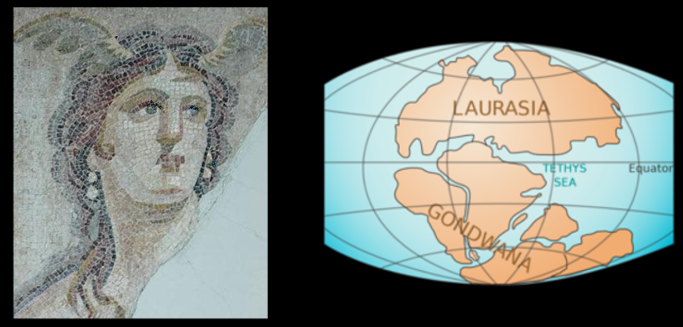The Enguri Hydrology Initiative
Welcome to the website of the Enguri Hydrology Initiative. Here you can find more about it and its activities.
The mission
Establishment of a consultative group for active collaboration, data and information sharing, and the introduction of international best practice for utilizing hydro-meteorological data and hydrological modelling for hydropower operators and others in the Enguri River Basin.
The system
Having in mind security (for example during floods) and the economy (better use of water for hydropower generation), one of the major capabilities being developed within the Enguri Hydrology Initiative is hydrological forecasting. Forecasting is not always easy. Indeed, good forecasts require data and time-tested models. Additionally, perfect forecasts are very rare and, most often, predictions are uncertain. The forecasting system for the Enguri River basin is being set up at the same time as the hydrometric and meteorological monitoring networks are expanded (measurement of discharges, rainfall, snow cover, temperature, etc.). In such a situation, a system that is both very reliable and highly adaptable is needed.
The Tethys Forecasting System is a state-of-the-art forecasting tool that employs artificial intelligence to achieve great reliability and adaptability. It can start generating reliable forecasts today and, as the monitoring networks in the catchment and other sources of data are enhanced, use the additional data to improve the forecasts (reducing their uncertainty).
This website
You can find the latest news about the Enguri hydrology Initiative below. More information and details about the system can be found below or with the help of the menu on the left. The data and forecasts can be accessed from the map or, perhaps more conveniently, using the dashboard. Documents and other files shared among members of the Enguri Hydrology Initiative can also be found on a dedicated section (menu on the left).
The information shared in this site is sensitive, and only members of the Enguri Hydrology Initiative have access. Please log in before going into a restricted area.
News
The most recent news about the Enguri Hydrology Initiative are shared below.
Upcomming EHI Workshop 2
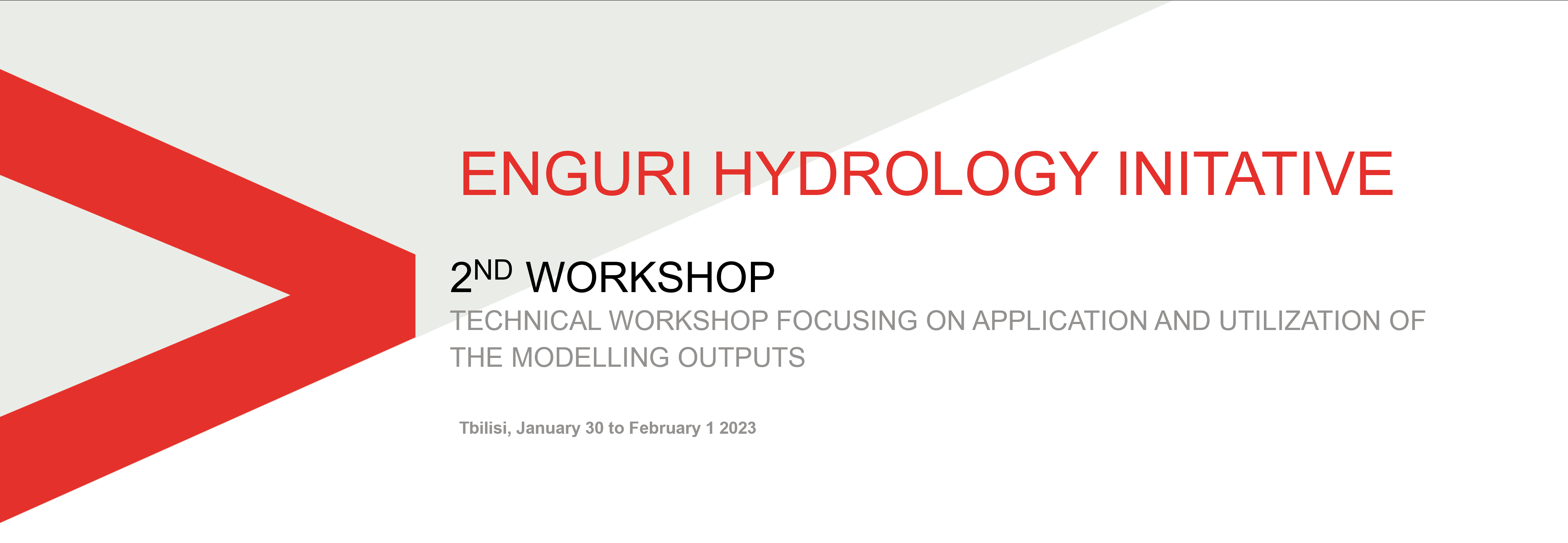
The second workshop of the EHI will take place in Tbilisi, from the 30th of January to the 1st of February 2023. It is a technical workshop that joins local and international experts to discuss important topics related to hydrological modeling, with important applications to water resources planning and operational forecsting. Presentations and Q&A slots will be complemented by dedicated sessions aimed where the participants will get their hands dirty" and directly solve technical challenges."
by José Pedro Matos, 2023.01.19, 12:16.
Upcomming EHI Workshop 1

The first workshop of the EHI will take place in Tbilisi, from the 26th to the 28th of September 2022. It is a technical workshop that joins local and international experts to discuss important topics such as hydrometeorological data collection, climate change and sediment transport. Presentations and Q&A slots will be complemented by dedicated sessions aimed where the participants will get their hands dirty" and directly solve technical challenges."
by José Pedro Matos, 2022.09.09, 10:48.
Discussion of Institutional Arrangements for the Enguri Hydrology Initiative
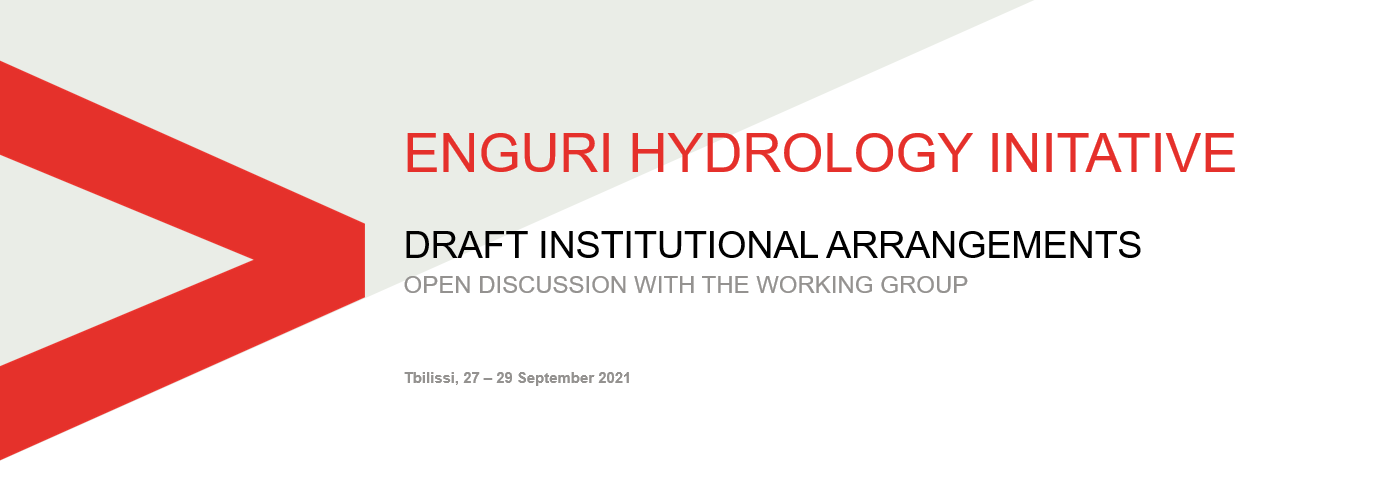
The Enguri Hydrology Initiative aims to be more than a consulting project. Aiming high, the Initiative wants to bring together different key stakeholders acting on the Enguri River basin for a long-term collaboration.
The institutional arrangements necessary to make that goal come true are now under discussion the Working Group of the project.
by José Pedro Matos, 2021.10.04, 08:39.
Field assessment of the monitoring network

A mission was dedicated to evaluate potential sites for collecting discharge data in several key locations of the Enguri River basin.
The conclusions of this mission will be instrumental to procure monitoring equipment and reinforce both the knowledge about local water resources and strengthen forecasting capabilities.
by José Pedro Matos, 2021.09.21, 08:36.
Kick-off of the Enguri Hydrology Initiative

The official kick-off of the Enguri Hydrology Initiative was held online in June 2021, with the participation of the Georgian Energy Development Fund (GEDF) and the project team from Stucky Ltd.
This event marks the start of the scoping phase, during which local stakeholders will be contacted, the hydrometeorological data collection in the Enguri River basin will be assessed, and next steps will be defined.
by José Pedro Matos, 2021.06.28, 08:35.
Technical details
The website
The Tethys Forecasting System is based on open-source technology. Its base programming language is Python, which offers the almost unique possibility of using a single language to program the data manangement and visualisation tool (the website) and the scientific code required to prepare and run the forecasts. The database behing Tethys is MySQL and Tethys itself runs on a Django web server. To speed things up, the code at the heart of the forecasting system was written in openCL are performed in parallel using a Graphics Processing Unit (instead or in parallel to multiple CPU cores). With this, years-worth of probabilistic forecasts can be computed in a matter of seconds.

Data
The system operates based on numerical weather forecasts and ground stations. The weather forecast data comes from the Global Forecasting System (GFS) by the USA National Atmospheric and Oceanic Agengy (NOAA). The forecasts go up to 16 days and are retrieved daily at a resolution of 0.5x0.5 deg. Ground data comes mainly from ZRA. The database daily collects information from both automatic and manual weather and hydrometric stations within and in the vicinity of the Vakhsh catchment. Below, examples of temperature, precipitation, and snow depth forecasts produced by GFS are displayed.
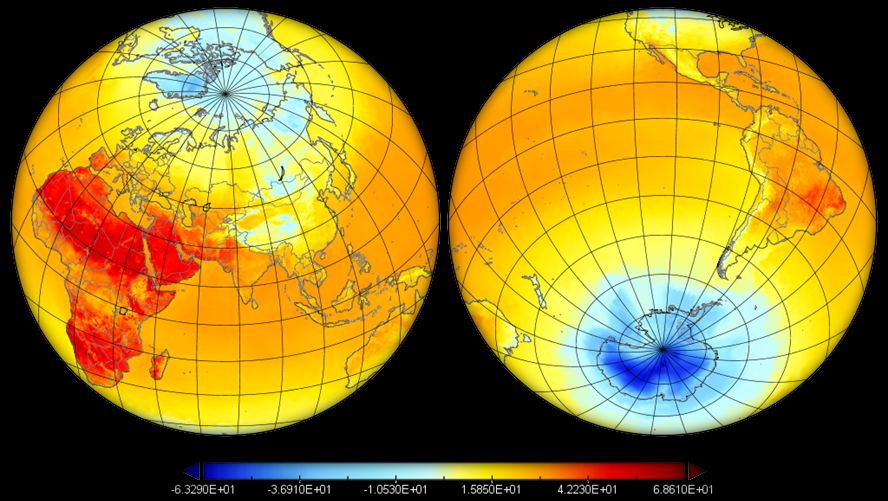


Hydrological modelling
Optionally, the forecasts produced by Tethys can also benefit deterministic conceptual hydrologic models, reaping the best of the deterministic and probabilistic approaches.
Models are specifically calibrated for the region in question and the Tethys system acts as a filter, in a procedure whereby its internal states and parameters are automatically adapted in case of a large departure from the observations. The quality of the deterministic predictions is evaluated using the Nash-Sutcliffe Efficiency.
Probabilistic forecasting
Probabilistic forecasting extends the traditional deterministic approach by associated uncertainty (i.e. potential errors) with every prediction.
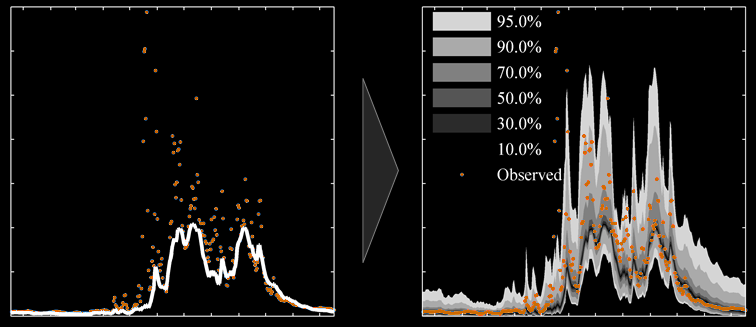
Doing so is not straightforward because the error is not always the same. Predictive errors of hydrological series in particular are affected by issues such as heteroscedasticity (errors are usually greatest during high flows), non-normality (often hydrological probability distributions differ from the Gaussian distribution), or autocorrelation (errors in consecutive timesteps are usually related, meaning that errors cannot be considered independent). Such features render the implementation of analytical solutions for probabilistic forecasting impractical.
The previous points do not mean that attempts at estimating uncertainty are not usually made. In fact, recognizing its importance, operational forecasting systems often include ways to model uncertainty. In most cases, however, such efforts are computationally expensive and bounded by important modeling assumptions, leading only to rough estimations. Fortunately, it is easy to assess whether a probabilistic prediction is reliable or not. One way to do this is by computing a predictive quantile-quantile plot (see example below). In a predictive quantile-quantile plot, a statistically reliable prediction will fall on a diagonal line. Departures from that line indicate discrepancies between observations and the prediction and can be used to learn what may be wrong with the model.

Generalized Pareto Uncertainty
The probabilistic forecasting capabilities of Tethys are its distinguishing feature. The Generalized Pareto Uncertainty algorithm used by Tethys does not assume much about the process being simulated, learning everything it needs to know from historical data. Due to this, a large array of variables can be predicted if there is a sufficiently long historical series available (preferably 10 years or more).
GPU works by combining a very large number of regression models to produce its probabilistic forecasts. Each one of these regression models is a deterministic function of the type y=f(X, W), where X represents several input variables that may be used as inputs, and W is a matrix of model parameters. For example, we may want to predict discharge one week from now based on today's observations of discharge, temperature, and precipitation; that would look something like this: Qt+7=f([Qt, Tt, Pt], W).
The choice of an adequate regression model depends on the problem at hand. To keep things general, an allowing Tethys to predict a wide range of variables, artificial neural networks were chosen. Artificial neural networks are machine learning or artificial intelligence models that come in different shapes and sizes (see figure below). In Tethys, the multi-layer perceptron type was chosen. These models emulate the human brain at a sub-symbolic level. Based on layers of "neurons" and the "synapses" connecting them, multi-layer perceptrons can be trained with historical observations and learn to predict the behavior of complex systems.
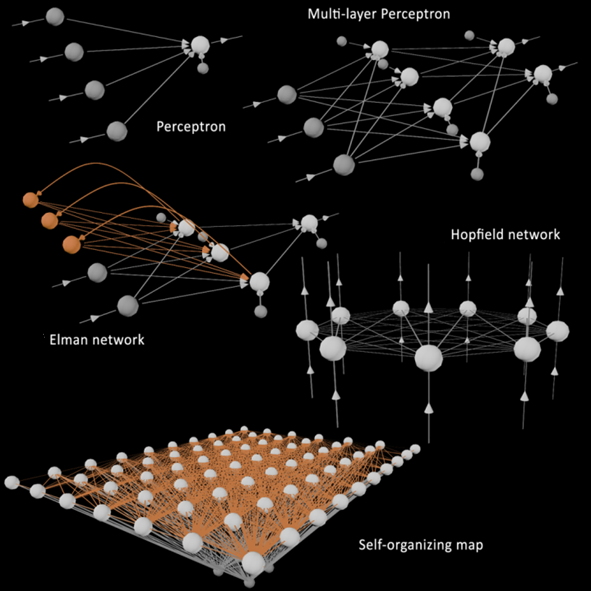
But that was only one model. For a probabilistic prediction the Generalized Pareto Uncertanty combines thousands of such models, each with its own specific parameters (W). The key is to find the adequate parameters for each regression model f. The Generalized Pareto Uncertanty uses a custom multi-objective optimization code that aims for:
1) each prediction being as close as possible to observations;
2) creating regression models that make predictions between always below obsevations to always above them.
The training process is rather complicated (follow this link for further information), but it can be summarized in the figure below. In the figure, each point represents a regression model (in this case an artificial neural network). The x-axis represents non-exceedance, which can be related to probability. For example, a non-exceedance of 0 means that, for the historical data set used to train the models, predictions were never exceeded by observations. Conversely, a non-exceedance of 1 is obtained when historical predictions have consistently been above observations. In order to guarantee that, for all non-exceedances, predictions are as close as possible to observations, it is important to account for the error associated with each model (y-axis). Trough several epochs (or iterations) of training, the Generalized Pareto Uncertainty algorithm will find the sets of parameters that allow the many regression models to cover the full range of non-exceedances (from 0 to 1) with as little error as possible.

An example of the Generalizing Pareto Uncertainty model in the operation is shown below, where three figures illustrate the start, middle, and end phases of model training. On the left plot the non-exceedance vs. error plane is portrayed; in the middle, the quantile-quantile plot is displayed (perfect reliability along the diagonal); and on the right plot the time series is shown (obsevations in red, probabilistic predictions in shaded gray). When the training starts predictions are very bad (right plot) reliability is poor (middle plot). As the training progresses (second figure), better parameters for each artificial neural network are found and predictive error is reduced (right plot). Also, reliability is dramatically improved (middle plot) and predictions become much better (right plot). When training is allowed to continue (third figure), the optimal parameters of reach artificial neural network will be found (left plot). Reliability will typically be excellent (middle plot), and the uncertainty associated with the predictions is further reduced (right plot).
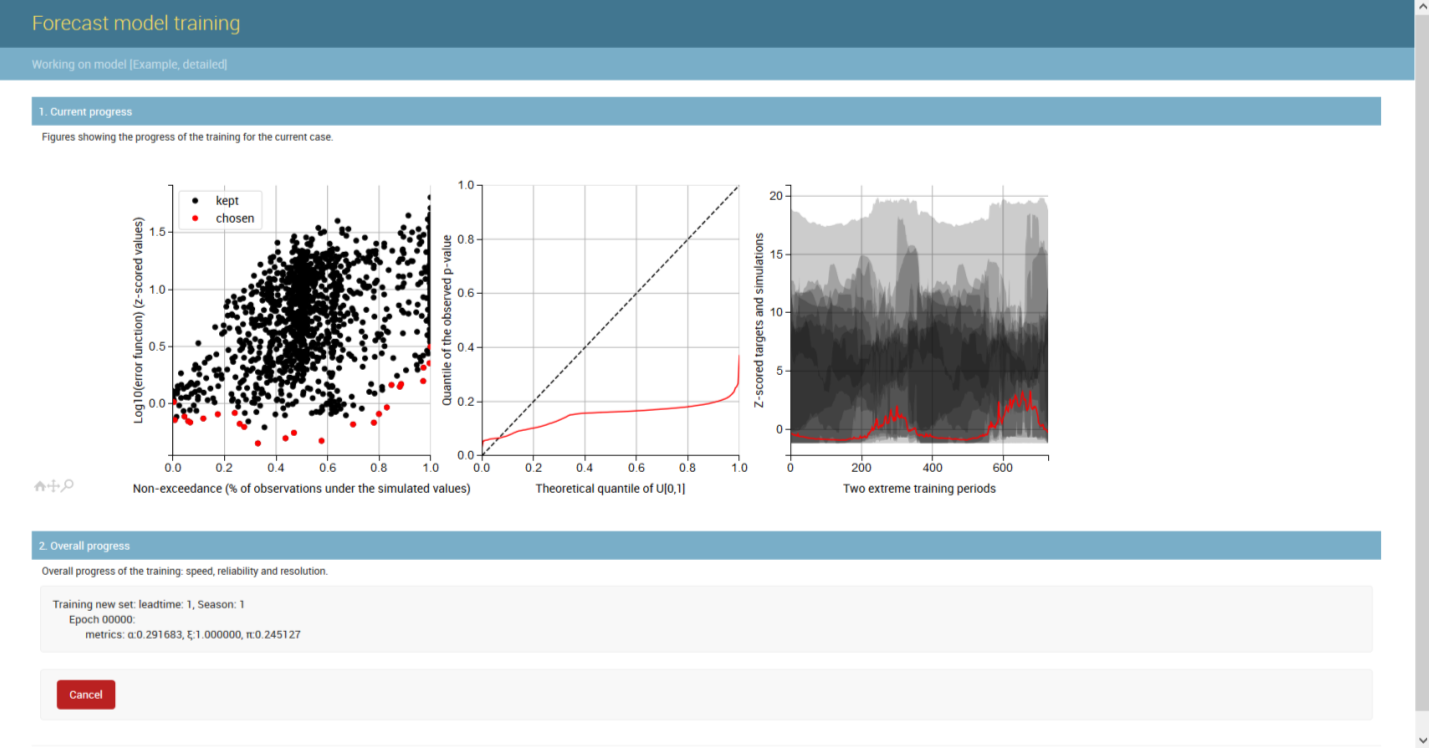
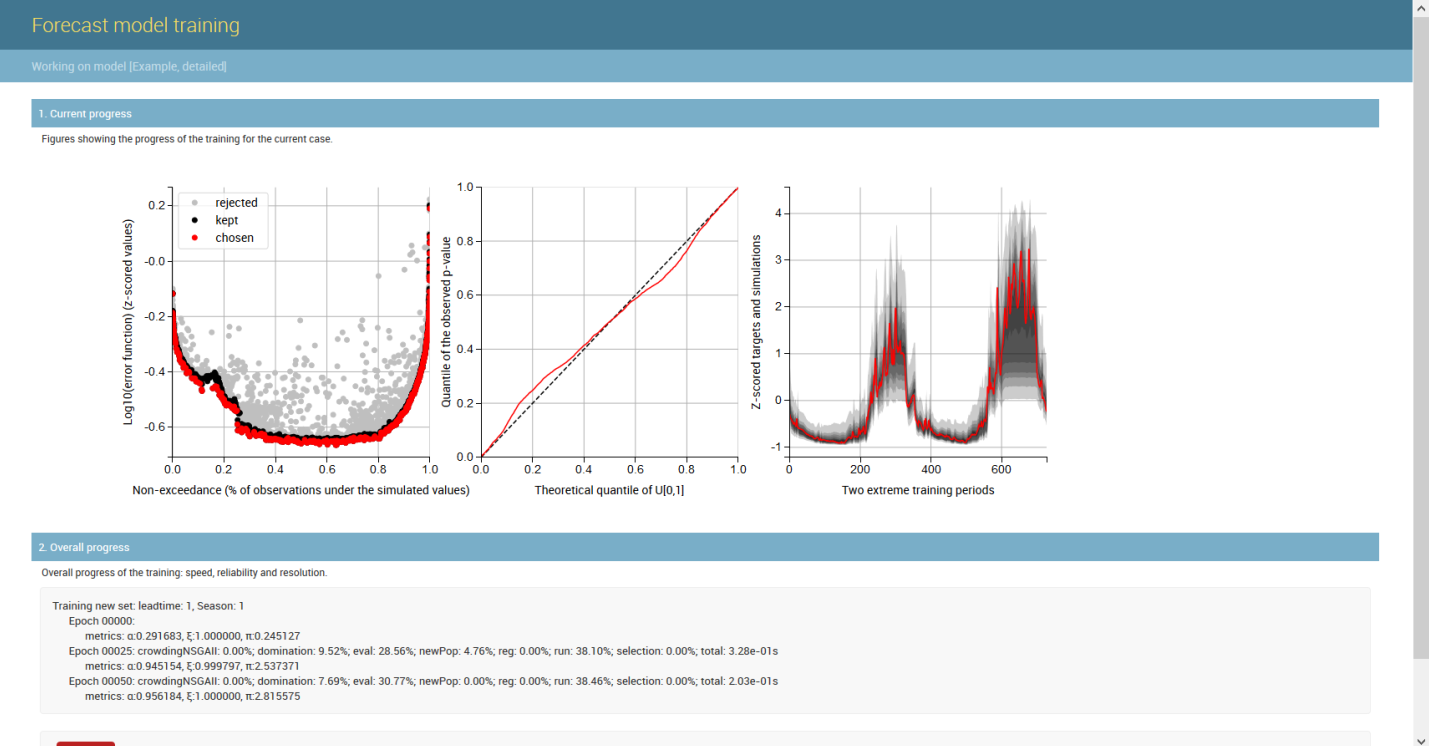

About
The project
The project is developed by Stucky Ltd. with the help of Swedish Meteorological and Hydrological Institute (SMHI), SD Strategies and local partners. The Client of the project is the Georgian Energy Development Fund (GEDF).
This is a 2-year assignment that is mainly financed mainly by the Austrian government (though the DRIVE fund). This financing is indirect and coordinated by the European Bank for Reconstruction and Development (EBRD). Funding is provided by EBRD to the GEDF, who acts as the Client and prime recipient of the project’s results.
Georgia’s electricity system depends on hydropower for 80% of its electricity generation. The heavy reliance of the system on hydropower leads to the reliance on electricity imports during the winter months and a summer surplus that is being exported mostly to the Turkish market. In this context, the Georgian government has worked on strengthening the interconnection with Turkey to allow for greater power exports. Georgia has significant potential for further growth in the sector and several major developments are ongoing, mostly led by private developers. In parallel, the electricity market in Georgia is undergoing major changes, with the introduction day-ahead and intra-daily energy markets.
These changes increase the value of hydrological data and analysis capabilities in the country on both short and long terms. In fact, the day-ahead and intra-daily markets can benefit from reliable hydrological forecasting and the planning of new infrastructures can best be achieved when accurate and sufficiently long hydrologic series are available.
The Enguri River basin is of particular significance for the energy sector, currently hosting more than 50% of the national generation capacity; a share that is meant to grow even further with several additional hydropower plants under development. The most important hydropower plant (HPP) in the catchment and, in fact, for the Georgian electricity sector is Enguri (1’300 MW). Providing roughly 40% of the country’s energy generation, Enguri has been operating since the late 1970’s. The HPP is run by the state-owned Enghuresi LLC. Upstream from the dam, several hydropower plants are planned or under development. Examples are Nenskra (280 MW), Khudoni (700 MW) and Nakra. Overall, there are numerous smaller hydropower plants with a generation capacity of over 1,100 MW under development in the basin.
The installed capacity and remaining potential for hydropower development of the Enguri River basin fully justifies the focus of the EHI.
The strategy
The Enguri Hydrology Initiative aims to bolster cooperation among key organizations in the Enguri River Basin and enhance decision-making capabilities. To achieve these goals, the project will:
- Increase hydro-meteorological data acquisition capabilities and propose ways to enhance them.
- Develop hydrological models instrumental in addressing challenges such as security, climate change, or sedimentation.
- Promote cooperation among stakeholders by helping to establish protocols for data sharing and model ownership and setting up operational systems.
- Transfer knowledge so that local experts can independently tackle important issues such as hydrological forecasting or the optimization of hydropower production.
- Ensure the continuity of the work. Trough long-term planning and transfer of know-how and tools to local organizations the advancements achieved during the Project will endure after it ends.
Development of the forecasting system
The Tethys Forecasting System was developed at the École Polytechnique Fédérale de Lausanne (EPFL), in Switzerland, as part of the ADAPT Database research project. The initial development has been financed by the Swiss Competence Centre Environment and Sustainability (CCES) and EPFL. It aimed to produce reliable long-term hydrological forecasts for the Zambezi catchment in Southern Africa, a region where the hydrometric monitoring network is relatively sparse. Since its inception the system has been successfully applied in temperate and cold climates.
Prior to the present version of the system, dedicated to the Enguri River basin, Tethys has been developed by Stucky Ltd for Webuild and Hidroeléctrica de Cahora Bassa with the main aim of producing operational inflow forecasts for the Rogun and Cahora Bassa dams.
The logo
The logo is inspired on the representation of Nyami Nyami, the Zambezi River God of the Tonga, an ethnic group living mostly in Zambia and Zimbabwe, in the region of the Kariba Dam. It was at this location that Tethys was first tested.

The name
The name of the system - Tethys - has a double relationship with its purpose and history. Firstly, Tethys is a titan in Greek mythology know to be the mother of the greek river gods. Secondly, Tethys gave her name to the Tethys Ocean which, when the dinosaurs still roamed the earth, bathed the eastern shore of the Gondwana Continent (and thus ancient Africa). The fact that Tethys is historically connected to rivers and that the Zambezi drained to the Tethys Ocean inspired the name choice.
